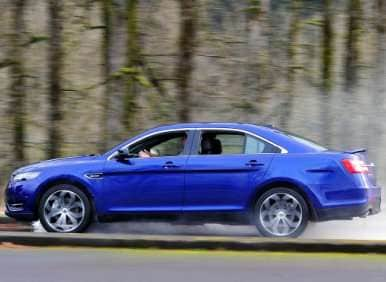Recent Articles
Popular Makes
Body Types
Road Test and Review - 2013 Ford Taurus SHO
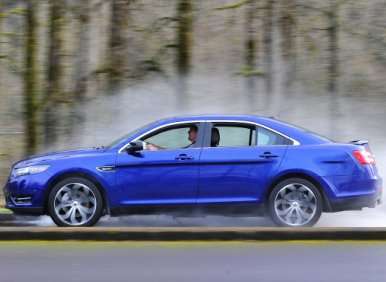
Many moons ago - well, in 1989 - Ford decided that it was time to offer the general public a hotted-up version of its most popular sedan, the Ford Taurus. Enter the Taurus SHO, a vehicle that combined a Yamaha-sourced V-6 with an available manual transmission and a sporty suspension system in order to create a fun-to-drive mid-size family car that would develop a cult following before disappearing from the market at the end of the next decade.
When Ford transformed the most recent edition of the now full-size Ford Taurus from also-ran to segment leader in 2010, it realized that there was room in the lineup to build on nostalgia as well as surprise the public with a version of the car that catered to enthusiasts who couldn't compromise on interior room, comfort or the number of doors they needed in a daily driver. Enter the new Taurus SHO, a vehicle that expands on the original model's high performance mission while also showcasing some of Ford's most recent technological breakthroughs.
2013 Ford Taurus SHO: Competition
The 2013 Ford Taurus SHO occupies a niche spot in the full-size sedan pantheon. In theory, the Taurus SHO is cross-shopped against equally-powerful, all-wheel drive editions of family cars like the Dodge Charger R/T and the Chrysler 300C, with the latter offering a level of luxury similar to that of the Ford to go with its appreciable acceleration. For those seeking a large, plush ride with a performance edge outside of the domestic scene it's necessary to seek out pricier options like the Hyundai Genesis R-Spec, the Acura RL and the Audi A6.
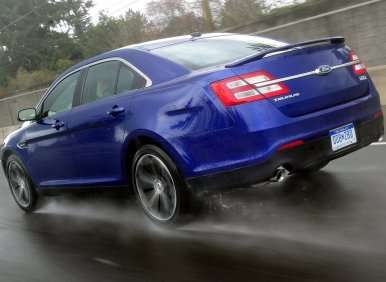
2013 Ford Taurus SHO: Pricing and Trim Levels
The 2013 Ford Taurus SHO is priced at an MSRP of $39,200, with a number of different options and packages available to further customize the vehicle and increase the total impact on your pocketbook. The 402A equipment group (including Active Park Assist, a blind spot monitoring system, and heated and cooled seats) costs $3,000, while the SHO Performance Package's enhanced suspension system, improved brakes, and other track-ready features adds $1,995 to the total price of the vehicle.
After summing up all the bells and whistles outfitted to our Ford Taurus SHO test vehicle (provided by Ford Canada) its MSRP came out roughly to $45,500.
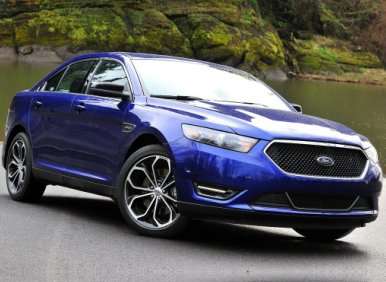
2013 Ford Taurus SHO: Exterior
The 2013 Ford Taurus SHO is without a doubt a performance sedan that wears a chip on its shoulder when it comes to styling. The Taurus SHO is all bulging muscles and gaping vents, from the trapezoidal front grille opening that is honeycombed with black mesh and the LED accent lights gracing the side of the front fascia all the way to its huge hood, inset SHO badge, and jaunty rear wing perched on the trunk lid.
The SHO is also massive. Most of the comments we got from passersby and passengers alike centered on the sporty Taurus' sheer bulk, a characteristic that is impossible to ignore when standing alongside its huge proportions. The Taurus doesn't seem overly long or particularly wide - just really, really big, especially when taking into account its all-wheel drive ride height and the wheel gap between the tops of its 20-inch tires and fender lips. Our Taurus SHO rode on optional rims that featured the letters SHO embossed on one spoke per wheel, a nice detail that contrasted against the lack of subtlety displayed elsewhere on the vehicle. The SHO is in your face and proud of it, a visual personality that will definitely appeal to a certain demographic of performance-hungry drivers.
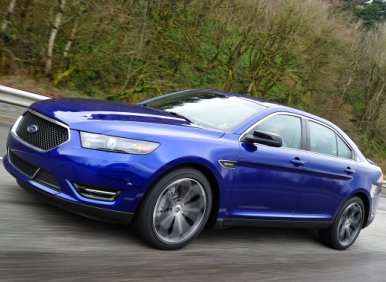
2013 Ford Taurus SHO: Interior
At first, the passenger compartment of the 2013 Ford Taurus SHO doesn't seem match the expectations inspired by its plus-size exterior. This is because the accommodations in the Taurus are arranged in such a way as to surround the driver and front passenger with a tall dash and a prominent center console that creates an almost snug, cockpit-like feel. There is plenty of room to spare, but the overall impression is one of sinking down into the seats with the console on one side and the sedan's high beltline on the other visually shrinking your surroundings.
The rear row is a different story entirely, with gobs of space for shoulders, legs, and hips combined with seat heaters and the same comfortable leather upholstery afforded those riding up front. It's worth mentioning that SHO is stitched into the top of the forward buckets just below the headrests, adding a premium touch to the black leather package.
The dual-cowl dashboard is formed out of a reasonably soft material that can also be found on the sedan's armrests. There are still a few areas that feel a bit more plasticky than perhaps they should, but there are also smooth, premium surfaces such as the very useful three-panel beverage and cell phone compartment doors that surround the Taurus' shifters in the center console.
A significant part of the Ford Taurus SHO experience has to do with its tech-heavy driver interface and entertainment systems. Our test vehicle came with the improved edition of the brand's MyFord Touch feature, which replaces traditional analog gauges in front of the driver with a pair of LCD screens that can be customized to display vehicle information and navigation system commands, move through the car's media system interface, or make phone calls. The screens flank a center-mounted analog speedometer and are complemented by a large LCD touchscreen.
Much has been written about the MyFord Touch system, in particular referencing just how difficult to use some Ford owners have found it to be. Our week spent with the feature had us come away with mixed feelings towards the system. On the one hand, it's extremely encouraging to see a car company push forward with a vehicle display system that represents a genuine break with the status quo, particularly one like MyFord Touch which can help the driver stay in touch with so many different vehicle systems and features in a central location. The implementation of the system's interface, however, had us shaking our fists at the dashboard on more than one occasion.
The biggest issue we encountered with MyFord Touch had to do with the pair of arrow controls mounted on the steering wheel. Each control pad is canted at an angle, due to the design of the wheel spokes themselves, which meant that pushing on the down arrow or the right arrow to move through a menu shown on one of the smaller LCD screens would frequently instead back us out of a particular selection instead of pushing forward. In fact, we had to push each button at the southeast or northeast cardinal point rather than simply hit the straight up or right-side arrow keys in order to maintain some semblance on being able to us the feature, and even then there was a chance we'd accidentally find ourselves on the wrong screen again. The experience, one might imagine, was maddening, and it made us abandon the steering wheel controls for the relative sanity of the larger touchscreen when using Bluetooth or selecting a satellite radio channel.
For the most part, the touchscreen was well implemented, dividing itself into four distinct sections on boot-up: Bluetooth devices, navigation, entertainment and climate. Each of these categories could be blown up into full-screen status by touching a thin tab at the top or bottom corner of their respective screen areas, with smaller icons representing vehicle setup options and the ability to return to the home screen nestled at the bottom center of the display.
We used the SYNC voice interface and Bluetooth feature extensively in the Ford Taurus SHO, and came away with only a few quibbles. Speaking addresses to the navigation system was relatively straightforward, although at times the system was incapable of deciphering city names, even when spelled out. From a communications perspective, we were unable to download Android phonebooks to the car, but the link between the phone and the vehicle was quickly reestablished each time we got behind the wheel. It was annoying, however, to discover that when the center display was set to the navigation screen the SYNC system would only respond to voice commands related to nav. Dialing a phone required exiting the nav display and then opening up the Bluetooth tab before being able to speak the number you wanted to call. Bluetooth streaming of music from an Android phone was hit or miss, with the barebones interface frequently incapable of displaying song titles, file names, or even moving back and forth from one track to another.
Mounted directly underneath the touchscreen was a glossy panel that contained the vehicle's climate controls, as well as a center dial that could be used to adjust music volume. To the left and right of this dial - underneath the prominent SONY logo - were two rectangular buttons marked SOURCE and SOUND, redundant controls for the stereo system that were surrounded by reams of empty black space. The climate controls were simple to use, but the panel itself looked out of place with the rest of the dashboard's layout. Incidentally, if you want to line in an external media player, make sure you bring a 1/8-inch to RCA breakout cable, as the Taurus' stereo system doesn't offer a 1/8-inch input.
A final note on the SHO's interior. We enjoyed the ambient lighting feature and its ability to display several different color choices ranging from deep blue to an electric green. We were slightly less enamored, however, with the dimmer switch for the interior lights themselves, which was buried to the left of the steering wheel on the underside of the dash. The button to decrease the interior brightness would frequently "freeze" the display on the MyFord Touch screen, forcing us to hit it again and again in the hopes that the lights would continue to dim. Strangely, we encountered a bug where the dome lights would turn themselves on while we dimmed the dash lights, refusing to turn off until we opened and closed the driver's door.
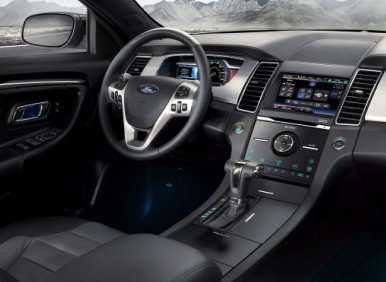
2013 Ford Taurus SHO: Powertrain and Fuel Economy
The 2013 Ford Taurus SHO comes with a twin-turbo, EcoBoost 3.5-liter V-6 that generates 365 horsepower and 350 lb-ft of torque. A six-speed automatic that features steering wheel-mounted paddle shifters is the only available gearbox for the SHO, and all-wheel drive is also included as standard equipment. Fuel mileage for the Ford Taurus SHO checks in at 17-mpg in city driving and 25-mpg on the highway - numbers that are very close to all-wheel drive edition of the far less powerful base Taurus, and certainly impressive given the engine's output.
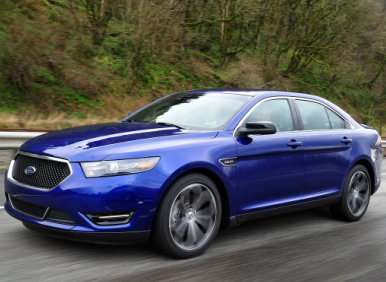
2013 Ford Taurus SHO: Driving Impressions
The 2013 Ford Taurus SHO is a heavy car, weighing in at almost 4,400 lbs. This makes the EcoBoost engine's performance that much more astounding, as it is capable of rocketing the sedan to 60-mph in less than six seconds as well as providing it with enough forward thrust to climb up to license-revoking highway speeds if the driver simply breathes on the gas pedal. The Taurus SHO's paddle shifters transmit relatively quick upshift and downshift inputs to the vehicle's gearbox, but we found it more enjoyable to simply leave the selector in Sport mode and let the computer do the work for us. Braking was a complaint on 2012 and earlier models, but the issue was addressed for the current model year and we experienced no scary moments when asking the SHO to arrest its forward momentum,
In terms of handling, the SHO's all-wheel drive system provides gobs and gobs of grip, helping the enormous car tackle corners at speeds that would seem reckless in a front-wheel-only automobile. Not once did the Taurus SHO's tires squeal at us in complaint as it was put through its paces, and body roll was acceptable when pushed through tighter, gymkhana-style curves. The suspension system was up to the task of traversing rough pavement without shaking the rear end of the car out of line even with the steering wheel cranked, and on the highway the vehicle's ride was composed and quiet. Driving the Taurus SHO from Montreal to Calabogie Motorsports Park outside of Ottawa in order to sample the latest iteration of the Ford Mustang on the track had us well-rested and ready for lapping, and after a full day of redline antics the car was a welcome companion on the 125 mile trip back home.
One feature of the 2013 Ford Taurus SHO that did disappoint us was its automated parking system. Advertised as being able to parallel park the car with no input from the driver other than gas and brakes, we tried again and again to engage the feature in a variety of different situations and space sizes. Each time the result was the same: a prompt on the center screen telling us that the system was using its ultrasonic sensors to search for a parking spot, a task that it never completed. We knew that the sensors were working properly as the other safety features that relied on them functioned as intended during our time with the car. This had us feeling left out of the 'gee-whiz' excitement of what we were hoping would be a fun and simple-to-use system.
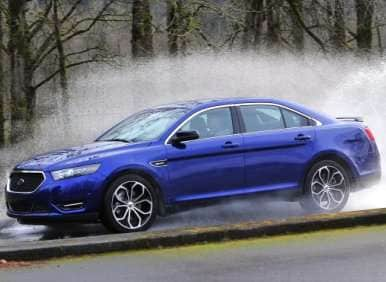
2013 Ford Taurus SHO: Safety
The 2013 Ford Taurus SHO is equipped with seat-mounted side impact airbags up front, forward airbags, and side curtain airbags to protect passengers in the event of a collision. Electronic stability control and traction control are also standard. Our SHO tester was additionally equipped with a blind spot warning system that worked quite well, lighting up an indicator on the sideview mirrors when a vehicle was detected alongside the sedan. A backup camera was also included in order to assist when reversing up the car - a welcome addition given the very small rear window we would have otherwise been forced to peer out of.
The SHO's blind spot warning system was bundled with a 'cross-traffic' detection system that is intended to alert the driver should an automobile approach from either side while the car is backing up. We had a scare when the feature activated while reversing next to a concrete pylon, causing us to slam on the brakes only to discover that we were in no danger of any kind of impact.
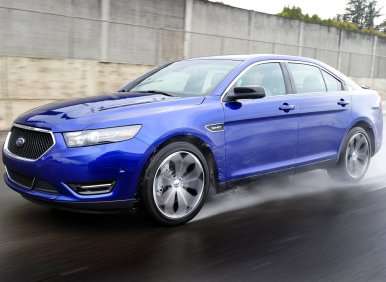
2013 Ford Taurus SHO: Final Thoughts
The 2013 Ford Taurus SHO is a genuine achievement, a full-size, all-wheel drive sedan that offers respectable performance without sucking down fuel at a scary rate. The EcoBoost engine family certainly delivers on its promise of efficient horsepower, and we were unable to detect even a hint of lag from the setup's twin-turbos during our entire time with the vehicle.
The inside of the Taurus SHO, while not as upscale as one might expect, is a comfortable place to eat up hundreds of highway miles, and the sedan's entertainment features are also a welcome distraction from the monotony of the road. The Ford falls down when it attempts to overreach in providing us with high tech conveniences. MyFord Touch is an excellent idea that hasn't quite been implemented (even in its second iteration) as flawlessly as it would need to be in order to gain broad acceptance amongst new car buyers. If drivers raised on a steady diet of Nintendo and Playstation games have difficulty navigating your user interface, it's time to take a step back and re-evaluate the situation.
What We Like About The 2013 Ford Taurus SHO:
- Outstanding acceleration from the EcoBoost V-6
- Sticky grip thanks to standard all-wheel drive
- Aggressive styling
- Great comfort on long trips, excellent interior room, enormous trunk.
We Aren't So Hot On:
- Clunky steering wheel controls for MyFord Touch system
- Occasionally finicky voice command system
- Did we mention the MyFord Touch controls? We're bringing them up again.
